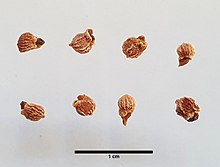
Eryngium alpinum, the alpine sea holly, alpine eryngo or queen of the Alps, is a herbaceous perennial plant in the family Apiaceae.

Calystegia sepium is a species of flowering plant in the family Convolvulaceae. It has a subcosmopolitan distribution throughout temperate regions of the North and South hemispheres.

Phyteuma orbiculare, common name round-headed rampion or Pride of Sussex, is a herbaceous perennial plant of the genus Phyteuma belonging to the family Campanulaceae.
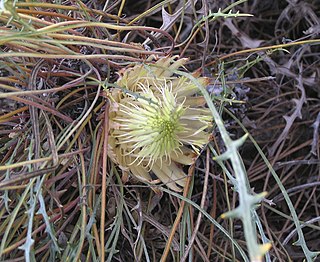
Banksia rufa is a species of prostrate shrub that is endemic to the south-west of Western Australia. It has broadly linear, pinnatifid or pinnatipartite leaves with between five and twenty lobes on each side, yellow, orange or brownish flowers in heads of forty or more, and glabrous, egg-shaped follicles.

Dactylorhiza maculata, known as the heath spotted-orchid or moorland spotted orchid, is an herbaceous perennial plant of the family Orchidaceae. It is widespread in mountainous regions across much of Europe from Portugal and Iceland east to Russia. It is also found in Algeria, Morocco, and western Siberia.

Pimelea microcephala, commonly known as mallee rice-flower or shrubby rice-flower is a species of flowering plant in the family Thymelaeaceae and is endemic to mainland Australia. It is an erect shrub with compact heads of male or female, white to yellow or greenish flowers on separate plants, the heads surrounded by 2 or 4 leaf-like involucral bracts.

Pimelea flava is a species of flowering plant in the family Thymelaeaceae and is endemic to south-eastern Australia. It is a shrub with narrowly elliptic to egg-shaped leaves arranged in opposite pairs, and compact clusters of 9 or more flowers with 2 or 4 elliptic to circular involucral bracts at the base. The flowers and bracts are white or yellow, depending on subspecies.
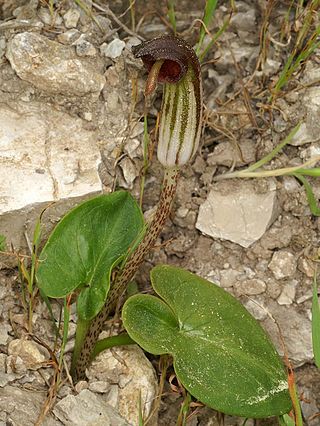
Arisarum is a genus of flowering plants in the family Araceae. It is native to the Mediterranean region, east to the Caucasus and west to Macaronesia.

Serapias vomeracea, common name long-lipped serapias or plow-share serapias, is a species of orchid in the genus Serapias.

Pimelea ligustrina is a species of flowering plant in the family Thymelaeaceae, and is endemic to south-eastern Australia. It is a shrub with lance-shaped or narrowly elliptic leaves arranged in opposite pairs, and clusters of creamy-white, white or pinkish flowers usually surrounded by 4 or 8, greenish to reddish brown involucral bracts.
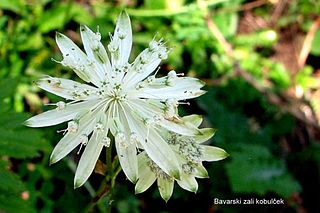
Astrantia bavarica, common name masterwort, is a species of flowering plant in the family Apiaceae, native to Eastern alps. Growing to 30 cm (12 in) tall by 30 cm (12 in) broad, it is an herbaceous perennial, much used in gardens.

Astrantia major, the great masterwort, is a species of flowering plant in the family Apiaceae, native to central and eastern Europe. Growing up to 90 cm (35 in) tall by 45 cm (18 in) broad, it is an herbaceous perennial, much used in gardens.
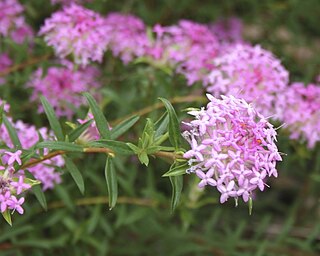
Pimelea rosea, commonly known as rose banjine, is a species of flowering plant in the family Thymelaeaceae and is endemic to the south-west of Western Australia. It is an erect shrub with narrowly elliptic leaves, and clusters of pale pink to reddish-purple flowers surrounded by 4 egg-shaped involucral bracts.

Leucopogon obovatus is a species of flowering plant in the heath family Ericaceae and is endemic to the southwest of Western Australia. It is an erect shrub with hairy young branchlets, variably-shaped, simple leaves, and erect clusters of 3 to 15 white, bell-shaped flowers on the ends of branches and in upper leaf axils.

Arisarum simorrhinum is species of flowering plant of the family Araceae. It is native to the western Mediterranean Basin.

Pimelea cracens is a species of flowering plant in the family Thymelaeaceae and is endemic to the southwest of Western Australia. It is an erect, spindly shrub with narrowly elliptic to egg-shaped leaves and creamy green to pale yellow flowers surrounded by 6 or 8 yellowish or pale green and reddish involucral bracts.
Cryptandra minutifolia is a flowering plant in the family Rhamnaceae and is endemic to the south-west of Western Australia. It is a spreading shrub with oblong to elliptic leaves and clusters of white or pink, tube-shaped flowers.
Stenanthemum notiale is a species of flowering plant in the family Rhamnaceae and is native to Western Australia, South Australia and Victoria. It is a small, erect to prostrate shrub with hairy young stems, egg-shaped leaves with the narrower end towards the base, and clusters of white to cream-coloured or greenish yellow, densely shaggy-hairy flowers.

Pimelea latifolia is a species of flowering plant in the family Thymelaeaceae and is endemic to eastern Australia. It is a shrub with hairy young stems, egg-shaped leaves with the narrower end towards the base, and greenish-yellow to white, tube-shaped flowers.
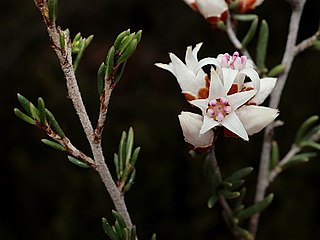
Cryptandra speciosa is a species of flowering plant in the family Rhamnaceae and is endemic to eastern Australia. It is a shrub with clusters of linear to narrowly elliptic leaves, and clusters white, tube-shaped flowers in leaf axils.



